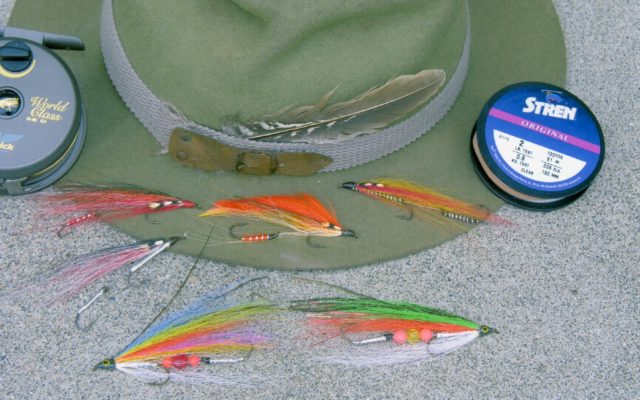A few weeks ago, I wrote an article about tying flies to pass time during Maine’s long winters. Since then I’ve had a bunch of emails and texts, a couple of phone calls and several random face-to-face questions about my favorite spring fly patterns.
Some of the fishermen had never heard of a couple of the streamer patterns I mentioned, and others wanted an opinion on bright colors versus dull or feather wing versus bucktail.
Let’s discuss hooks first. Streamers being cast while wading streams or floating small ponds are single hook, while streamer flies being trolled behind a boat on large lakes or rivers tend to be tandem using two hooks connected — one behind the other. I favor a 2X to 4X long shank in size 6, 8, or 10 for most Aroostook brooks, rivers and small ponds, selecting size by water depth and speed. For tandems, I prefer a size 4 front hook and a size 6 trailer hook.
Some fly tiers combine a size two and four, usually for very high water, and others use a pair of size 4 or size 6 for both front and back hooks. Often it’s a matter of personal preference and past experience for the size combos, but one technique I highly recommend when tying tandems is to reverse front and rear hook orientation. With the front hook in a normal downward barb position, I attach the trailer hook facing barb upward with a short length of plastic covered wire.
I refuse to use just wire anymore, it bends and gets misshapen after only one or two hook-ups and fights. Only plastic encased wire or heavy monofilament will do as a connector between the hooks to prevent kinking and allow the fly to track straight when trolled after catching multiple fish. The opposite oriented hooks are more likely to stay in place through multiple leaps and runs than when both hooks are down-facing. At least one of the pair is also more likely to set and hold when a strike occurs because of the opposite facing barbs.
There are two basic styles of spring streamer flies. The attractor pattern has bright colors in body and wing, and the imitator is more dull but resembles a minnow in color and shape. To confound fly selection further, each of the two types have particular patterns tied with bucktail wings, feather wings or a combination of both. The color, silhouette and material all determine fly effectiveness in cold, dingy, debris-filled spring water conditions.
The two to three weeks just after ice out on each regional lake or pond often yield the most consistent action and some of the largest fish of the year. Proven bait fish imitator streamers include a gray ghost, Supervisor, nine-three and Barnes Special. All of these have feather wings. The most common attractor patterns carried by most local trollers, oddly enough, are all bucktail or hair-winged. They include a Miss Sharon, red and white bucktail, black nose dace, Mickey Finn and little brook trout. Every early season, fly fisherman should have these tandem patterns in his fly box.
Big fish don’t get that size by being stupid. I truly believe that trout and salmon become accustomed to certain patterns of flies and having a half dozen unique, less known feathered offerings is a great idea. If you don’t tie your own flies, you will have to find someone who does, since most of these will be difficult to find in most fly shops. Just as a guideline, I never troll one pattern for more than an hour without a bite, some days I change every half hour.
My top four feather wing streamers that are seldom heard of but very effective include the governor, blue devil, Colonel Bates and Ouananiche Sunset. For bucktail or mixed hair and feather wing streamers, the unique four are a Jock Scott bucktail, Millers special, Magog Special and Indian puddle. Find a pattern, tie the fly and fish will feast.
I do use an interesting trolling technique to make the most of all these great streamer patterns. It’s a common tactic for drift boat casting to rainbow and brown trout on large western rivers. Most anglers cast two flies; a dry fly and a wet fly on a dropper line or a wet fly and a small nymph on a dropper line. I troll a two streamer rig, one each imitator and attractor tandem streamer but with a different set up than a dropper.
My dual fly rig uses a three-way swivel with one eye attached to the trolling line, a 15-foot leader tied to the second eye and a 7-foot leader attached to the third eye. A split shot sinker the size of a pencil eraser is crimped halfway up the shorter leader to help the second fly run about a foot deeper than the long leader fly. I usually tie the attractor fly on the short line and if a fish checks it out but refuses to bite, it still might grab the smelt imitator running behind.
Buy or tie your streamer flies now and get your trolling rods, reels and lines ready, as open water is only weeks away. If you depend on only two or three specific streamer patterns, you may be missing out on catching more and larger fish. Change is good, especially during spring trolling when steady pressure with the same few flies is common.
- Here are a few of the streamer fly attractor and imitator style tandem streamers that writer Bill Graves has ready for ice out lake fishing. (Bill Graves)





